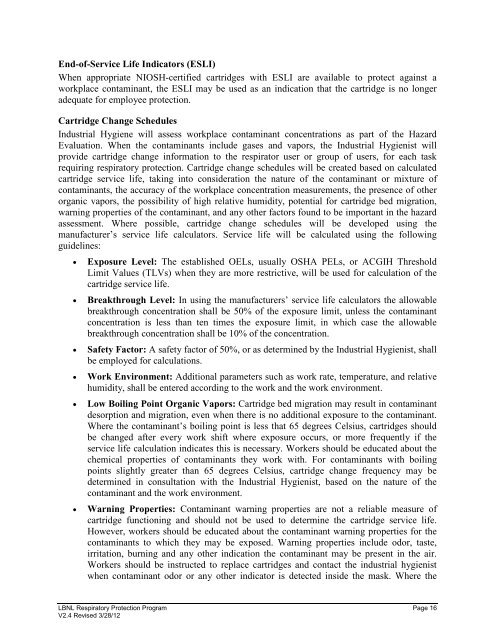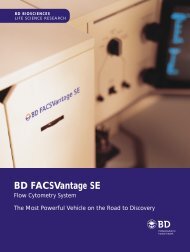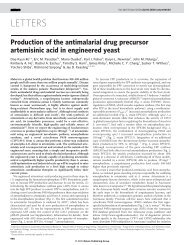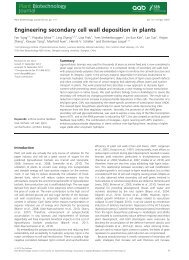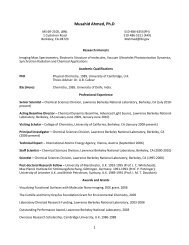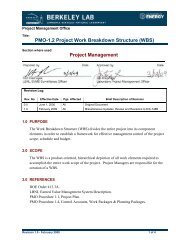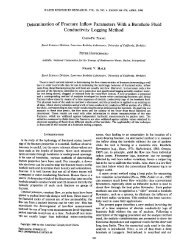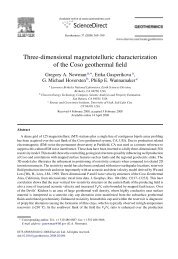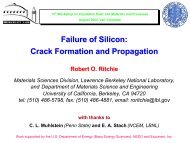LBNL Respiratory Protection Program - Lawrence Berkeley National ...
LBNL Respiratory Protection Program - Lawrence Berkeley National ...
LBNL Respiratory Protection Program - Lawrence Berkeley National ...
You also want an ePaper? Increase the reach of your titles
YUMPU automatically turns print PDFs into web optimized ePapers that Google loves.
End-of-Service Life Indicators (ESLI)<br />
When appropriate NIOSH-certified cartridges with ESLI are available to protect against a<br />
workplace contaminant, the ESLI may be used as an indication that the cartridge is no longer<br />
adequate for employee protection.<br />
Cartridge Change Schedules<br />
Industrial Hygiene will assess workplace contaminant concentrations as part of the Hazard<br />
Evaluation. When the contaminants include gases and vapors, the Industrial Hygienist will<br />
provide cartridge change information to the respirator user or group of users, for each task<br />
requiring respiratory protection. Cartridge change schedules will be created based on calculated<br />
cartridge service life, taking into consideration the nature of the contaminant or mixture of<br />
contaminants, the accuracy of the workplace concentration measurements, the presence of other<br />
organic vapors, the possibility of high relative humidity, potential for cartridge bed migration,<br />
warning properties of the contaminant, and any other factors found to be important in the hazard<br />
assessment. Where possible, cartridge change schedules will be developed using the<br />
manufacturer’s service life calculators. Service life will be calculated using the following<br />
guidelines:<br />
• Exposure Level: The established OELs, usually OSHA PELs, or ACGIH Threshold<br />
Limit Values (TLVs) when they are more restrictive, will be used for calculation of the<br />
cartridge service life.<br />
• Breakthrough Level: In using the manufacturers’ service life calculators the allowable<br />
breakthrough concentration shall be 50% of the exposure limit, unless the contaminant<br />
concentration is less than ten times the exposure limit, in which case the allowable<br />
breakthrough concentration shall be 10% of the concentration.<br />
• Safety Factor: A safety factor of 50%, or as determined by the Industrial Hygienist, shall<br />
be employed for calculations.<br />
• Work Environment: Additional parameters such as work rate, temperature, and relative<br />
humidity, shall be entered according to the work and the work environment.<br />
• Low Boiling Point Organic Vapors: Cartridge bed migration may result in contaminant<br />
desorption and migration, even when there is no additional exposure to the contaminant.<br />
Where the contaminant’s boiling point is less that 65 degrees Celsius, cartridges should<br />
be changed after every work shift where exposure occurs, or more frequently if the<br />
service life calculation indicates this is necessary. Workers should be educated about the<br />
chemical properties of contaminants they work with. For contaminants with boiling<br />
points slightly greater than 65 degrees Celsius, cartridge change frequency may be<br />
determined in consultation with the Industrial Hygienist, based on the nature of the<br />
contaminant and the work environment.<br />
• Warning Properties: Contaminant warning properties are not a reliable measure of<br />
cartridge functioning and should not be used to determine the cartridge service life.<br />
However, workers should be educated about the contaminant warning properties for the<br />
contaminants to which they may be exposed. Warning properties include odor, taste,<br />
irritation, burning and any other indication the contaminant may be present in the air.<br />
Workers should be instructed to replace cartridges and contact the industrial hygienist<br />
when contaminant odor or any other indicator is detected inside the mask. Where the<br />
<strong>LBNL</strong> <strong>Respiratory</strong> <strong>Protection</strong> <strong>Program</strong> Page 16<br />
V2.4 Revised 3/28/12


